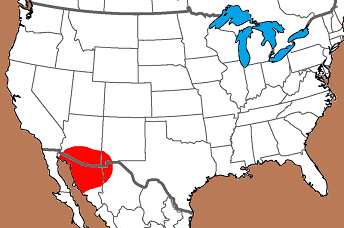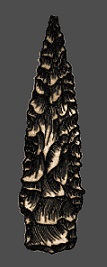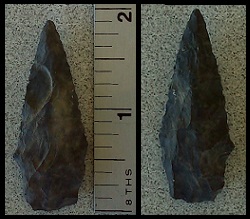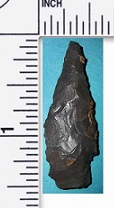Outline is Representative of Size and Shape:


Name Details:
Identified By: Michelle N. Stevens and R. Jane Sliva
Named For:
Date Identified: 2002
Type Site: Multiple sites in the Cienega Valley and the Tucson Valley
Comment: See Kiva, Vol 67, Number 3, 2002
Identified By: Michelle N. Stevens and R. Jane Sliva
Named For:
Date Identified: 2002
Type Site: Multiple sites in the Cienega Valley and the Tucson Valley
Comment: See Kiva, Vol 67, Number 3, 2002
Point Validity:
Valid type
Stevens is a distinguished and well published anthropologist for the Center for Desert Archaeology. Sliva has conducted extensive analyses of flaked stone and constructed and extensive database on flaked stones of Arizona. This type was named in a professional publication and has many professional references. This is considered a valid type.
Stevens is a distinguished and well published anthropologist for the Center for Desert Archaeology. Sliva has conducted extensive analyses of flaked stone and constructed and extensive database on flaked stones of Arizona. This type was named in a professional publication and has many professional references. This is considered a valid type.
Empire Stemmed
Cluster: Description of Physical Characteristics and Flaking Pattern:
This is a medium triangular stemmed point with an elliptical to diamond shaped cross section. The blade is long, narrow, and slightly excurvate and is commonly serrated. The shoulders are weak to absent and at an upward angle. The stem is most commonly straight and only slightly narrower than the shoulders. The base ranges from straight to convex and is usually crudely steeply flaked, or may be unfinished. Grinding of the hafting region is commonly seen and is usually light as well as basal thinning. This point has a random flaking pattern and is usually finished with fine pressure flaking.
Size Measurements:
Total Length - average 49 mm, Stem Length - average 10 mm, Blade Width - 18 mm, Neck Width - 15 mm, Basal Width - 16 mm, Thickness - Width - 7 mm
Total Length - average 49 mm, Stem Length - average 10 mm, Blade Width - 18 mm, Neck Width - 15 mm, Basal Width - 16 mm, Thickness - Width - 7 mm
Commonly Utilized Material:
Local medium to fine grained igneous and metamorphic rocks, Examples made from Obsidian was not seen (Stevens and Sliva, 2002).
Local medium to fine grained igneous and metamorphic rocks, Examples made from Obsidian was not seen (Stevens and Sliva, 2002).
Additional Comments:
These points are similar to the San Pedro points, but differ in that they have long narrow blades with weak to absent shoulders forming a straight stem that is only slightly narrower than the blade. In addition to having a narrower blade, the stem of the Empire point is narrower than is commonly seen on the San Pedro point. The length of both points are similar which rules out that the Empire point is a re-worked San Pedro point (Stevens and Sliva, 2002).
These points are similar to the San Pedro points, but differ in that they have long narrow blades with weak to absent shoulders forming a straight stem that is only slightly narrower than the blade. In addition to having a narrower blade, the stem of the Empire point is narrower than is commonly seen on the San Pedro point. The length of both points are similar which rules out that the Empire point is a re-worked San Pedro point (Stevens and Sliva, 2002).
Distribution:

Distribution Comments:
This point is primarily found throughout the Gila River region. This point is found with decreased frequency from the Gulf of California into central Arizona and southwestern New Mexico. This point has been reported at the La Playa site in Sonora and Costa Seri.
Age / Periods:
Date: 3,200 - 2,000 B.P.
Cultural Period: Late to Transitional Archaic
Glacial Period: Neoglacial to Roman Warm
Culture:
Date: 3,200 - 2,000 B.P.
Cultural Period: Late to Transitional Archaic
Glacial Period: Neoglacial to Roman Warm
Culture:
Age Details:
Based on the radiocarbon dating of several sites and the association with San Pedro points, these points are most likely associated with the San Pedro phase. These points have also been found infrequently at seven other sites that have associations with the Cienega Phase. This suggest that these points were primarily used during the San Pedro Phase and was discontinued during the early Cienega Phase.
Based on the radiocarbon dating of several sites and the association with San Pedro points, these points are most likely associated with the San Pedro phase. These points have also been found infrequently at seven other sites that have associations with the Cienega Phase. This suggest that these points were primarily used during the San Pedro Phase and was discontinued during the early Cienega Phase.
Other points in this cluster / Related / Associated Points:
San Pedro
San Pedro




